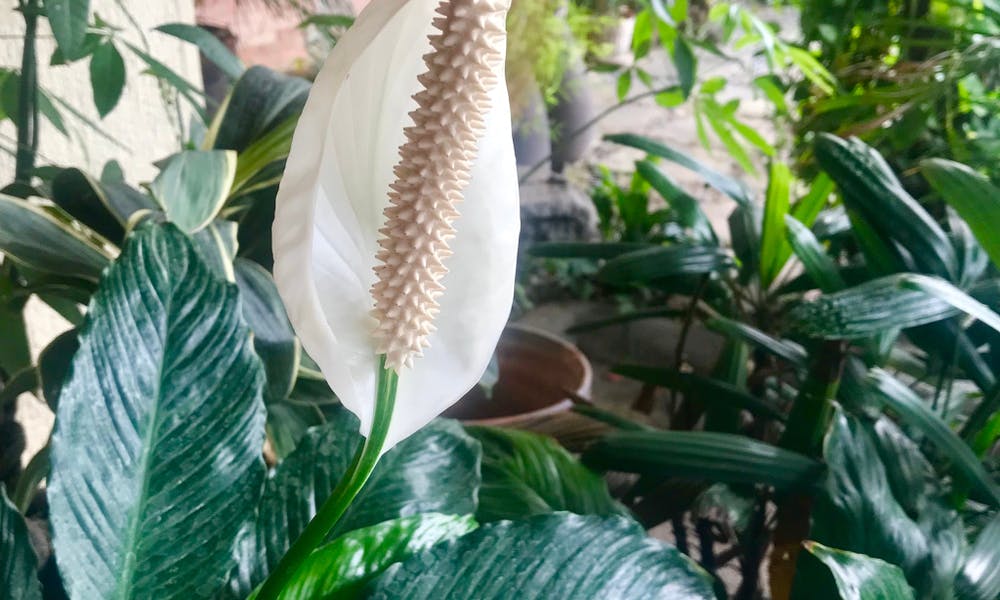The peace lily is an adaptable indoor plant with flowers similar to a calla lily, requiring low maintenance. The bright part of the flower has a white, hood-like sheath. Let’s read more about:
* Origin and history of peace lilies
* Precautions regarding peace lily for pet owners
* How to grow and care for peace lily
Origin and History of Peace Lilies
The peace lily is a perennial plant native to the tropical forests of America. It grows up to 24 – 40 inches, and it is vibrant and graceful. Specimens with heights between 32 and 50 inches can also be found. It generally blooms in spring, its flower resembling the shape of a large leaf with many petals. It has a pestle with pollen in the middle and bright yellow seeds.
If you carefully take care of peace lilies, these plants may bloom once more in autumn. Blooming periods might last for a minimum of two months and, after the flowers die, a long non-flowering period follows. Peace lilies like the shadow and darker spaces such as offices, bedrooms, libraries, or even salons and hospital reserves.
These plants are part of the Araceae family and are very popular. There is a large variety of peace lilies of various sizes. Most are planted in large pots that are placed on the floor due to the impressive height and size of their flowers and their big and bold leaves.
Mauna loa supreme (a Spathiphyllum hybrid) is perhaps the most popular midsize variety. It can reach 4 feet tall and it has bronze-green foliage with plenty of large cupped spathes. This tropical shade plant helps to clean the air we breathe, according to NASA. Their list of the ten plants that help cleaning the household air includes the peace lily.
Precautions Regarding Peace Lily for Pet Owners
The peace lily is poisonous to your pets, especially to cats or dogs. This is because the peace lily contains a compound known as oxalate. When ingested, oxalates can irritate the animal’s digestive system, including the mouth. It is likely, however, that the pet stops eating the peace lily immediately because of the quick irritation that occurs. This helps to avoid severe poisoning.
Additionally, pets that ingest leaves of peace lily salivate abundantly and start shake their heads. Because cats are usually very curious pets, it is recommended to avoid growing peace lilies in your home. You should place plants away from objects that would help cats have access to the plant, such as furniture and others.
What is more, the oxalate can lead to an inflammatory reaction when it is ingested by dogs. In simpler terms, dogs can experience immediate swelling of the tongue, mouth, neck, and even the entire upper respiratory tract. If your dog happens to be poisoned with a peace lily, take them to your veterinarian for treatment. After being intoxicated once, most dogs are discouraged and they don’t try again to eat the leaves of the poisonous plant.
To keep your dog away from peace lilies, try to train your dog using verbal commands. If you have a yard, and you have a peace lily planted in the garden, you must ensure that the dog does not have access to it.
How to Grow and Care for Peace Lily
Peace lilies need mild sunlight. They love the pale light but also shade. Additionally, these plants grow well in fluorescent light and can show their true splendor in rooms without windows at all.
When the leaves of your plant turn yellow, this is an indication that the light is too strong. Therefore, you should be careful to place your plant at a distance of 6 to 8 feet from the window, and the window should be placed to the north or west.
The flower of the peace lily plant warns you when it needs water as the inflorescence curls and shrinks. It does not need much water and, generally, it is good to water the plant once a week. During the growing period, it is a great idea to sprinkle the leaves of the plant with water with very little nutrients, very low hardness, or distilled water. During the cold season, the plant needs less water. The plant is quite resistant and can be revived very quickly by splashing its leaves with water.
You should be careful with tap water because peace lilies are very sensitive to chlorine. If you have no other choice, you may also leave the tap water for 10-12 hours so that the chlorine level decreases. Then, you can water your peace lily.
The peace lily is an excellent indoor plant since it comes from a tropical climate. It prefers temperatures between 65 and 85 degrees F and also it enjoys the humid climate. Peace lilies die at temperatures below 45 degrees F and cold currents. Therefore, if you have air conditioners in your home, place peace lilies away from them.
The peace lily is an excellent houseplant because it prefers a temperature of 65-85 and a humid climate. The peace lily is not very sensitive to most diseases and, additionally, most insects also avoid it.
It can contact mites, aphids, and spiders; if you regularly remove the leaves of your plant, these insects cannot harm it. If the pests appear, you can spray it with insecticidal soap. If these pests multiply too much, you can spray the plant with insecticide.
All in all, the peace lily care is a beautiful indoor plant that loves warm temperatures and humid climates. It makes the perfect decorative plant for your bedroom or office, as it can thrive in shade and direct, strong sunlight can harm it. On the other hand, if you own pets, it is best to avoid this plant or to ensure that your pet does not have access to the peace lily.
